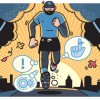Runner’s World
Coming back after a layoff? Science shows it’s easier than you may think to start again.
Many runners have been there-lacing up for the first time after an exercise hiatus, praying to the gods of running that there is such a thing as muscle memory. For example, Jeff Alexander, a 48-year-old public relations executive from Philadelphia, ran his first marathon in 1996 in 3:03, his second the following year in 3:07, and his third the year after that in 3:06. A semi-hypothermic experience at that final race coupled with major life changes, including a move and a marriage, caused Alexander to fall out of his marathon-training routine. And although he attempted to keep up with regular short runs, “beer often got in the way,” he says. But 10 years later, Alexander got back in the long-distance saddle. He trained for the 2008 Philadelphia Marathon and once again qualified for boston, with a time of 3:17-and a lot less difficulty than he had expected. “Heading back out, it felt very familiar,” he says. “I was up to 10 miles within the first month of training. I’d say the muscle memory was intact.”
Why It Sticks
Chances are, at some point in your life you’ll need time off from running. You’ll become a parent, get sick or injured, or take a midlife crisis sabbatical to learn to surf in Tahiti. But rest easy: With every run you’re currently taking, you’re “banking” muscle memory. Those deposits become a type of running nest-egg you can cash in down the road when you’ve had your last wipeout. “The more times you go over the memory now, the longer it will last,” says Amadeus Mason, M.D., of USA Track & Field’s sports-medicine and science committee and an assistant professor of orthopedics and family medicine at Emory University.
Sure, there is a psychological factor: Revisiting a sport, especially one that you once enjoyed, is far less intimidating and overwhelming than taking it up for the very first time. And confidence can certainly make reentry feel easier.
But experts say it’s more than that. To begin with, when you strengthen your muscles, they generate more nuclei, or “little protein factories,” that contain DNA necessary for increasing muscle volume, says Kristian Gundersen, professor of physiology at the University of Oslo in Norway. A study led by Gundersen in 2010 confirms that even after you quit exercising, these nuclei stick around, meaning a runner is one step ahead when he decides to get back into it.
“When you do an activity, the brain sends messages to your muscles in the form of electrical charges through pathways in the central nervous system, and the muscles send messages back,” says Matt Silvis, M.D., a primary-care sports-medicine physician at Penn State Milton S. Hershey Medical Center. It’s because of this constant feedback loop that the right muscles are activated, and at the right force, in order to perform a particular task. Do this task enough, and these nervous-system pathways become well-trodden, which is why you never forget how to ride a bike-or how to run.
You’re A Natural
You don’t just remember how to run-but how to run well. “Even after a long break, you’re going to be running more efficiently and wasting less energy than someone who is new to the sport,” says Adam Knight, Ph.D., assistant professor of biomechanics at Mississippi State University. “You can make the assumption you’ll get back in shape more quickly because of that.”
Perhaps the best news for runners is that these pathways don’t apply just to voluntary muscles like those in the legs, but to involuntary muscles, like the heart. “For former athletes, there is a lot of residual benefit to exercise within the circulatory system,” says Alfred Bove, M.D., Ph.D., professor emeritus of medicine at Temple University and past president of the American College of Cardiology. “In well-trained athletes, the heart is able to relax more easily, which minimizes shortness-of-breath issues. Also, the parasympathetic nervous system becomes more dominant than the sympathetic nervous system, meaning the heart is less stressed by exercise. Both of these adaptations have memory.”
http://www.runnersworld.com/running-tips/how-to-return-to-running

